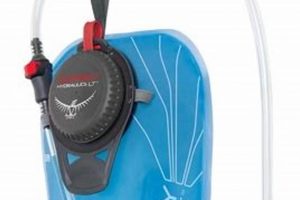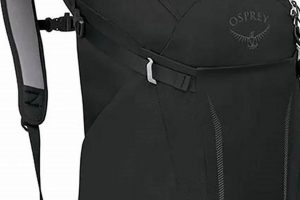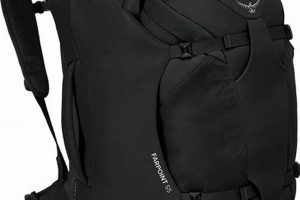The process of tailoring a carrying system from Osprey to the unique dimensions of an individual’s torso and hips constitutes a crucial step in ensuring optimal comfort and load distribution. This involves measuring torso length, hip circumference, and adjusting shoulder straps, hip belts, and sternum straps to achieve a secure and balanced fit. For example, a pack correctly adjusted will transfer the majority of the load weight to the hips, relieving strain on the shoulders and back.
Proper adjustment is vital for maximizing the efficiency and enjoyment of outdoor pursuits. A well-fitted pack enhances stability, reduces the risk of injury, and improves overall balance, particularly on uneven terrain. Historically, meticulous attention to adjustment has evolved from rudimentary carrying methods to sophisticated systems designed for prolonged use in demanding conditions. Ignoring these adjustment principles can lead to discomfort, chafing, and even long-term musculoskeletal problems.
This article delves into the specific steps involved in achieving a customized configuration. Subsequent sections will address torso measurement techniques, hip belt positioning, load management strategies, and troubleshooting common fitting issues. This will enable users to select the appropriate pack size and configure it for optimal performance and comfort.
Osprey Backpack Configuration
Maximizing the performance and comfort of an Osprey backpack necessitates adherence to specific configuration guidelines. The following tips outline crucial aspects of the adjustment process to ensure proper load distribution and minimize potential discomfort.
Tip 1: Torso Length Assessment: Prior to any adjustments, measure torso length accurately. Use a flexible measuring tape to determine the distance from the iliac crest to the C7 vertebra. This measurement serves as the primary determinant for pack size selection.
Tip 2: Hip Belt Positioning: The hip belt should sit comfortably on top of the iliac crest. Ensure the padded portion of the belt wraps around the hips, bearing the majority of the load. A properly positioned hip belt prevents slippage and distributes weight effectively.
Tip 3: Shoulder Strap Adjustment: After securing the hip belt, adjust the shoulder straps to conform to the contours of the shoulders. The straps should not bear the entire weight; they primarily stabilize the load and prevent excessive swaying. Avoid overtightening, which can restrict circulation and cause discomfort.
Tip 4: Load Lifter Angle: Load lifter straps, extending from the top of the shoulder straps to the pack frame, should form a 45-degree angle. This angle ensures that the load is pulled inward and upward, preventing the pack from sagging and maintaining proper posture.
Tip 5: Sternum Strap Utilization: The sternum strap connects the shoulder straps across the chest. Its primary function is to prevent the shoulder straps from sliding outward, maintaining stability and preventing chafing. Avoid excessive tightening, which can restrict breathing.
Tip 6: Dynamic Adjustment: Fine-tune adjustments while in motion. Slight alterations to strap tension can significantly impact comfort and stability, particularly during prolonged use on varied terrain.
By adhering to these principles, optimal load distribution, enhanced stability, and minimized discomfort during extended backpacking excursions are achievable. Consistent attention to adjustment is paramount for maximizing the intended functionality of the pack.
The subsequent section will address common challenges encountered during the configuration process and provide solutions for achieving a personalized and comfortable fit.
1. Torso Length Measurement
Accurate torso length measurement is a foundational element in the process of configuring an Osprey backpack for optimal fit and load distribution. Its purpose is to determine the appropriate pack size, ensuring the pack’s frame length aligns with the user’s back. This alignment is critical for transferring weight efficiently to the hips and preventing undue stress on the shoulders and spine.
- Role in Pack Sizing
Torso length dictates the selection of small, medium, large, or extra-large pack sizes. If the torso length is not properly measured, the pack frame may be too long or too short, resulting in improper weight distribution and discomfort. For example, a user with a 19-inch torso requires a medium-sized pack frame, while a user with a 21-inch torso needs a large frame. Utilizing an incorrect pack size negates the benefits of other adjustment features.
- Impact on Load Transfer
A correctly sized pack, based on torso length, facilitates optimal load transfer to the hips via the hip belt. When the frame length matches the torso length, the hip belt rests comfortably on the iliac crest, allowing the hips to bear a significant portion of the pack’s weight. Conversely, an improperly sized pack can result in the load being borne primarily by the shoulders, leading to fatigue and potential injury. In scenarios like extended hiking expeditions, this discrepancy becomes increasingly significant.
- Influence on Stability and Balance
Proper torso length measurement enhances stability and balance while traversing uneven terrain. A well-fitted pack maintains a lower center of gravity, reducing the risk of instability and falls. An incorrectly sized pack can shift the load unnaturally, making it more challenging to maintain balance. This is particularly relevant in activities like mountaineering or trail running where agility and stability are paramount.
- Effect on Adjustment Range
Torso length impacts the effectiveness of other adjustment features. When the pack frame is appropriately sized, shoulder straps and load lifter straps can be fine-tuned to achieve a customized and comfortable fit. An incorrectly sized pack limits the effectiveness of these adjustments, potentially resulting in persistent discomfort or improper load distribution. Thus, the accuracy of the torso length measurement sets the stage for the efficacy of subsequent adjustments.
In conclusion, precise torso length measurement serves as the cornerstone of successful Osprey backpack configuration. Its influence permeates all aspects of pack fit, impacting load transfer, stability, adjustment range, and overall comfort. Neglecting this initial step compromises the integrity of the entire system, leading to suboptimal performance and potential discomfort. Therefore, this measurement cannot be overstated in the pursuit of a well-fitted backpack.
2. Hip Belt Placement
Hip belt placement is a critical determinant of comfort and functionality within the overall configuration of an Osprey backpack. The hip belt’s location directly influences the degree to which the hips bear the load, mitigating strain on the shoulders and spine. An improperly positioned hip belt can negate the pack’s intended load-bearing capabilities, leading to discomfort and potential injury. For instance, if the hip belt sits too high, above the iliac crest, the shoulders will bear the majority of the weight, resulting in fatigue and potential nerve compression. Conversely, a belt positioned too low can slip, failing to provide adequate support and causing instability, particularly on uneven terrain.
Optimal placement necessitates positioning the hip belt such that the top edge rests comfortably on the iliac crest, the bony prominence of the hip. The padded portion of the belt should wrap securely around the hips, ensuring even weight distribution. This positioning allows the strong bones of the pelvis to support the bulk of the load, improving stability and reducing the risk of lower back pain. Load-bearing effectiveness is exemplified during long-distance trekking where a correctly positioned hip belt can significantly reduce the energy expenditure required for carrying a heavy pack.
In summary, proper hip belt placement is indispensable for effective Osprey backpack configuration. It is the primary means by which the pack’s weight is transferred to the lower body, enhancing comfort, stability, and overall performance. Challenges can arise due to individual anatomical variations, necessitating careful adjustment and experimentation. The principles of optimal hip belt placement are directly linked to the broader theme of ergonomic load carriage, emphasizing the importance of proper technique and equipment adjustment for minimizing physical strain.
3. Shoulder strap tension
Shoulder strap tension plays a crucial, yet often misunderstood, role in the overall effectiveness of Osprey backpack configuration. While the hip belt bears the majority of the load, shoulder strap tension dictates the degree to which the shoulders stabilize the pack and prevent sway. Inadequate tension results in excessive pack movement, leading to instability and chafing, particularly during dynamic activities. Overtightening, conversely, restricts circulation, causing discomfort and potential nerve compression. The correct tension represents a delicate balance, contributing to a stable and comfortable carrying experience.
Consider the scenario of ascending a steep incline. As the body leans forward, shoulder straps with insufficient tension allow the pack to shift backwards, pulling on the shoulders and disrupting balance. Conversely, properly tensioned straps keep the pack close to the body, minimizing movement and allowing for a more natural gait. Similarly, during downhill descents, excessive looseness can cause the pack to bounce, exacerbating impact forces on the spine. This principle applies regardless of the pack’s intended use, whether for hiking, climbing, or everyday commuting. The optimal tension mitigates these adverse effects, promoting stability and reducing the risk of injury.
In summary, shoulder strap tension is an integral component of the adjustment process. Its proper calibration is essential for achieving a balanced and comfortable fit. The goal is to achieve enough tension to stabilize the pack without impeding circulation or restricting movement. This fine-tuning contributes significantly to overall pack performance and user satisfaction by preventing unnecessary strain and enhancing stability. The relationship between shoulder strap tension and a well-fitted Osprey pack illustrates the importance of meticulous attention to detail in optimizing load-carrying efficiency.
4. Load lifter angle
Load lifter straps, extending from the top of the shoulder straps to the upper portion of the pack frame, exert a critical influence on the overall effectiveness of Osprey backpack configuration. The angle formed by these straps directly impacts the pack’s stability, load distribution, and comfort during extended use. An ideal angle, typically around 45 degrees, pulls the upper portion of the pack inward and upward, preventing sagging and maintaining proper alignment with the wearer’s center of gravity. When this angle is not properly established, the pack’s weight distribution is compromised, leading to discomfort and potential strain on the shoulders and back. For example, if the angle is too acute, the straps pull excessively on the shoulders, causing chafing and restricting movement. Conversely, if the angle is too obtuse, the straps become ineffective, allowing the pack to sag backwards and pull away from the body.
Practical significance lies in the application of this understanding during pack adjustment. When fitting an Osprey backpack, one should first ensure the torso length is correctly matched to the pack size. Subsequently, adjusting the load lifter straps to achieve the optimal angle becomes paramount. This often involves adjusting the overall length of the shoulder straps and fine-tuning the position of the load lifter attachment points. In real-world scenarios, such as navigating uneven terrain, the correct load lifter angle proves invaluable in maintaining balance and minimizing strain. Experienced backpackers recognize the tangible difference between a pack with properly adjusted load lifters and one that lacks this refinement, especially during arduous climbs or descents.
In summary, the load lifter angle is not a trivial detail but an integral component of successful Osprey backpack configuration. Its proper adjustment is essential for maximizing comfort, stability, and load-carrying efficiency. While achieving the ideal angle can require patience and experimentation, the resulting improvements in pack performance justify the effort. Challenges related to varying pack designs and individual body types can be overcome through careful observation and iterative adjustments. Ultimately, a thorough understanding of the load lifter angle contributes significantly to a more enjoyable and sustainable backpacking experience.
5. Sternum strap function
The sternum strap, a seemingly minor component of an Osprey backpack, plays a significant role in overall backpack fit and stability. Its primary function is to connect the shoulder straps across the chest, preventing them from sliding outwards, particularly during dynamic movements or on uneven terrain. This stabilization mitigates the potential for chafing or pressure points on the shoulders, contributing to improved comfort during extended use. The sternum strap does not bear a significant amount of weight; instead, its value lies in maintaining the integrity of the shoulder strap positioning, ensuring optimal load distribution as intended by the pack’s design. Real-world examples include hiking or trail running, where the strap prevents shoulder strap displacement with each stride, minimizing friction and fatigue. When appropriately adjusted within the fitting process, it assists in maintaining correct posture.
In practice, proper sternum strap adjustment involves finding the appropriate tension. The strap should be snug enough to prevent shoulder strap drift, but not so tight as to restrict breathing or impede chest expansion. Its vertical position should be approximately one inch below the collarbone. During Osprey backpack fitting, the sternum strap serves as a final adjustment point, solidifying the proper positioning of the shoulder straps after the torso length and hip belt have been correctly configured. Failure to utilize the sternum strap or improper adjustment can lead to shoulder strain, discomfort, and reduced overall efficiency. The absence of the stabilizing force leads to inefficient energy expenditure. This importance is further amplified when considering weighted loads.
In summary, the sternum strap is an essential, though often overlooked, element of the Osprey backpack fitting process. Its correct utilization ensures shoulder strap stability, promotes efficient load distribution, and enhances overall comfort during use. While seemingly simple, its functionality is integral to achieving a properly fitted and comfortable pack. Challenges in finding the optimal tension are addressed through iterative adjustments, emphasizing the importance of a holistic approach to backpack configuration. These principles apply to the broader theme of ergonomic load carriage, highlighting the significance of equipment design and individual adjustment in mitigating physical strain.
6. Dynamic adjustment
Dynamic adjustment refers to the practice of making incremental modifications to a backpack’s fit while in motion, accommodating changes in terrain, load distribution, or physical exertion. Within the context of Osprey backpack fitting, this represents a crucial step beyond the initial static configuration. Static fitting establishes a baseline, but real-world conditions necessitate ongoing refinement. A pack that feels comfortable while standing still may exhibit pressure points or instability during uphill climbs or rapid descents. Dynamic adjustment addresses these discrepancies, ensuring sustained comfort and optimal load transfer throughout an activity. Failure to engage in dynamic adjustment undermines the potential benefits of a meticulously executed initial fitting. For instance, a hiker traversing a rocky trail may need to tighten the hip belt slightly to prevent the pack from swaying, or loosen the shoulder straps during a less strenuous section to improve ventilation. The causes for adjustment are diverse, ranging from altered body posture to shifting contents within the pack.
The practical significance of dynamic adjustment lies in its ability to mitigate fatigue and prevent injuries. A properly adjusted pack minimizes friction, reduces pressure points, and maintains a stable load, all of which contribute to energy efficiency. Consider a mountaineer ascending a steep slope. As the angle of ascent increases, the load may shift, requiring subtle adjustments to the shoulder straps and load lifters to maintain balance and prevent strain on the lower back. Similarly, during a long-distance backpacking trip, changes in clothing layers or food consumption will alter the pack’s weight and center of gravity. Regular dynamic adjustments compensate for these shifts, ensuring the pack remains properly aligned with the body’s center of mass. The ability to make these adjustments on the fly, without interrupting the activity, is a key feature of many Osprey packs, enabling users to fine-tune the fit as needed.
In summary, dynamic adjustment is an indispensable component of effective Osprey backpack fitting. It allows users to adapt the pack’s fit to changing conditions, maximizing comfort, stability, and load-carrying efficiency. Challenges may arise from unfamiliarity with adjustment mechanisms or a lack of awareness of subtle changes in pack behavior. Addressing these challenges requires a proactive approach, paying close attention to how the pack feels and responding with timely adjustments. This proactive approach complements the long-term theme of ergonomic equipment use, highlighting the importance of adapting tools and techniques to individual needs and environmental demands, optimizing performance and mitigating risks.
7. Pack weight distribution
Pack weight distribution forms an integral element within Osprey backpack fitting. The manner in which weight is arranged inside the pack directly influences its stability, comfort, and overall load-carrying efficiency. Proper Osprey backpack fitting techniques aim to optimize the transfer of weight to the hips, reducing strain on the shoulders and back. However, a poorly packed load can undermine even the most meticulously executed fitting. Placing heavy items high and close to the spine promotes an upright posture and minimizes the tendency for the pack to pull backward. Conversely, placing heavy items low or far from the back shifts the center of gravity, increasing instability and potentially leading to discomfort or injury. Consider, for instance, a multi-day backpacking trip: if dense items such as water reservoirs and cookware are positioned at the bottom of the pack, the user will experience increased strain on their lower back and a greater tendency to lean forward, disrupting balance.
Efficient Osprey backpack fitting incorporates awareness of pack weight distribution principles. After measuring torso length, adjusting the hip belt, and fine-tuning the shoulder straps and load lifters, the user must consciously consider how the internal load is arranged. A common recommendation involves placing heavier items in the middle of the pack, between the shoulder blades, and closer to the spine. Lighter items can then be distributed around these heavier objects, filling out the remaining space. This approach promotes a more balanced and stable load. Furthermore, ensuring that items are securely packed, preventing them from shifting during movement, is crucial for maintaining consistent weight distribution. External attachment points can be used for bulky items, but care must be taken to ensure these items are evenly distributed to prevent imbalances.
In summary, pack weight distribution is not merely an afterthought, but a fundamental aspect of Osprey backpack fitting. The interaction between the pack’s design, the user’s body, and the arrangement of internal contents directly influences comfort, stability, and load-carrying efficiency. Challenges in achieving optimal weight distribution can arise from variations in pack size, shape, and load composition. Addressing these challenges requires a conscious effort to pack strategically, considering both weight and volume distribution. This understanding directly ties to the goal of ergonomic load carriage, emphasizing the importance of matching pack features, fitting techniques, and packing strategies to minimize physical strain and maximize performance.
Frequently Asked Questions
The following section addresses common inquiries related to achieving an optimal configuration of an Osprey backpack.
Question 1: How does an individual determine the appropriate Osprey pack size?
Pack size selection is primarily determined by torso length. Measuring the distance from the iliac crest to the C7 vertebra provides the necessary data for consulting Osprey’s sizing charts.
Question 2: Where should the hip belt be positioned for effective weight transfer?
The hip belt should be positioned such that the top edge rests comfortably on the iliac crest. The padded portion of the belt should wrap securely around the hips, distributing weight evenly.
Question 3: What is the ideal angle for the load lifter straps?
The load lifter straps should ideally form a 45-degree angle with the shoulder straps. This angle ensures proper upward and inward tension, preventing the pack from sagging.
Question 4: What constitutes correct shoulder strap tension?
Shoulder strap tension should be firm enough to stabilize the pack, but not so tight as to restrict circulation or cause discomfort. The shoulder straps should not bear the majority of the load.
Question 5: What is the function of the sternum strap, and how should it be adjusted?
The sternum strap connects the shoulder straps, preventing them from sliding outward. It should be adjusted to a snug but not restrictive tension, positioned approximately one inch below the collarbone.
Question 6: Why is dynamic adjustment necessary during activity?
Dynamic adjustment compensates for changes in terrain, load distribution, and physical exertion. Making incremental modifications while in motion ensures sustained comfort and optimal load transfer.
Proper configuration is a multifaceted process involving careful consideration of torso length, hip belt placement, strap tension, and dynamic adjustment. Mastery of these elements contributes significantly to the comfort and efficiency of load carriage.
The next section will address troubleshooting common fitting issues.
Osprey Backpack Configuration
This article has elucidated the core principles underpinning the effective utilization of Osprey load-carrying systems. It has emphasized the necessity of precise torso length assessment, the proper positioning of the hip belt, the careful adjustment of shoulder strap tension and load lifter angles, and the stabilizing function of the sternum strap. Furthermore, it has underscored the importance of dynamic adjustment during activity to accommodate changing conditions and maintain optimal comfort. Each of these elements contributes to the efficient transfer of weight and the mitigation of potential musculoskeletal strain.
The successful adaptation of Osprey load-carriage equipment requires diligent adherence to these configuration guidelines. The consequences of neglecting these protocols extend beyond mere discomfort, potentially leading to injury and compromised performance. Continued education and meticulous application remain paramount for maximizing the benefits of these advanced carrying systems. The pursuit of ergonomic load carriage necessitates a commitment to understanding and implementing these best practices.







![Best Osprey Kestrel 38L Backpack [Review & Guide] Ultimate Backpack Traveler Guide: Tips, Destinations & Budget Hacks Best Osprey Kestrel 38L Backpack [Review & Guide] | Ultimate Backpack Traveler Guide: Tips, Destinations & Budget Hacks](https://backpack-traveler.com/wp-content/uploads/2025/10/th-816-300x200.jpg)